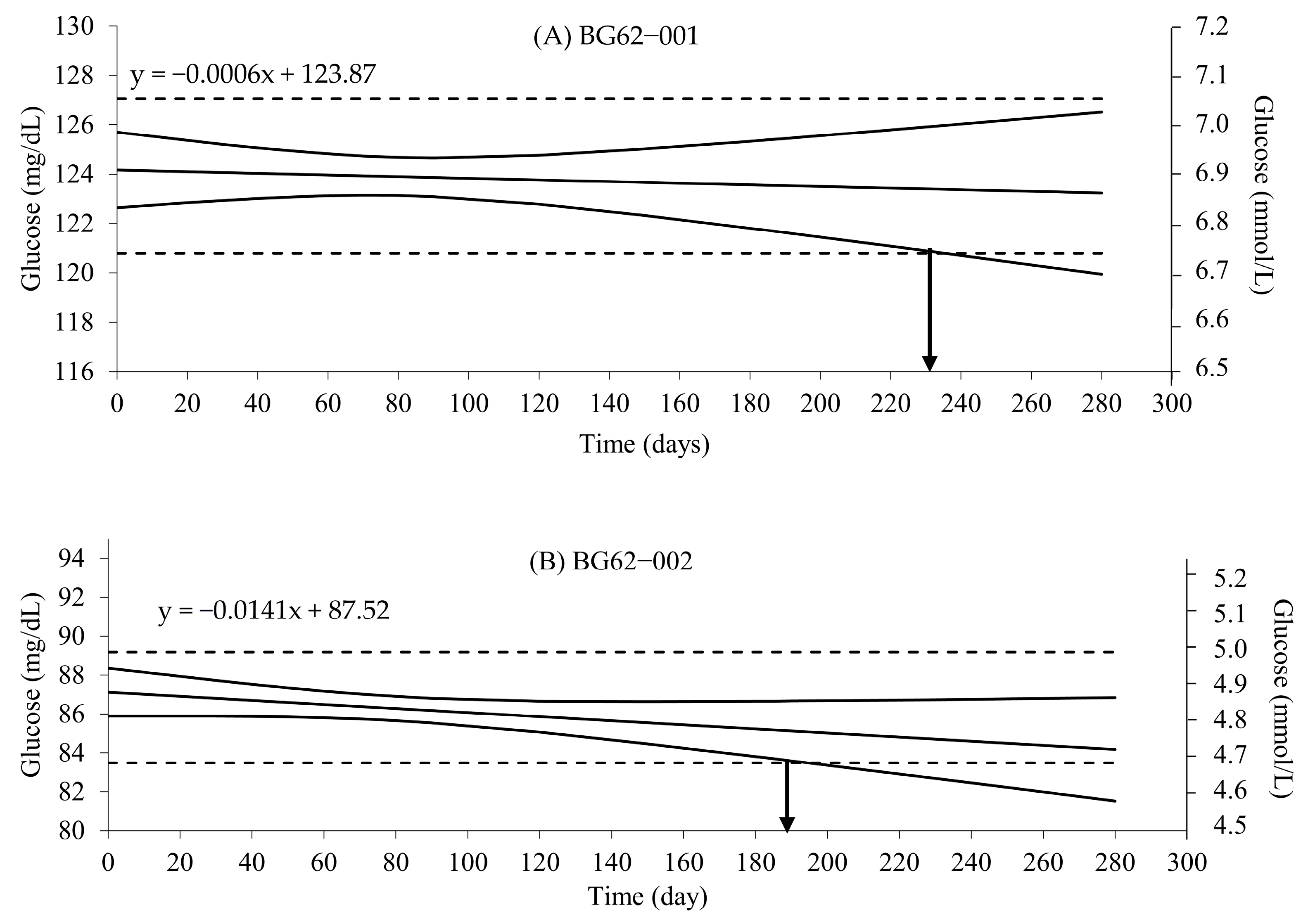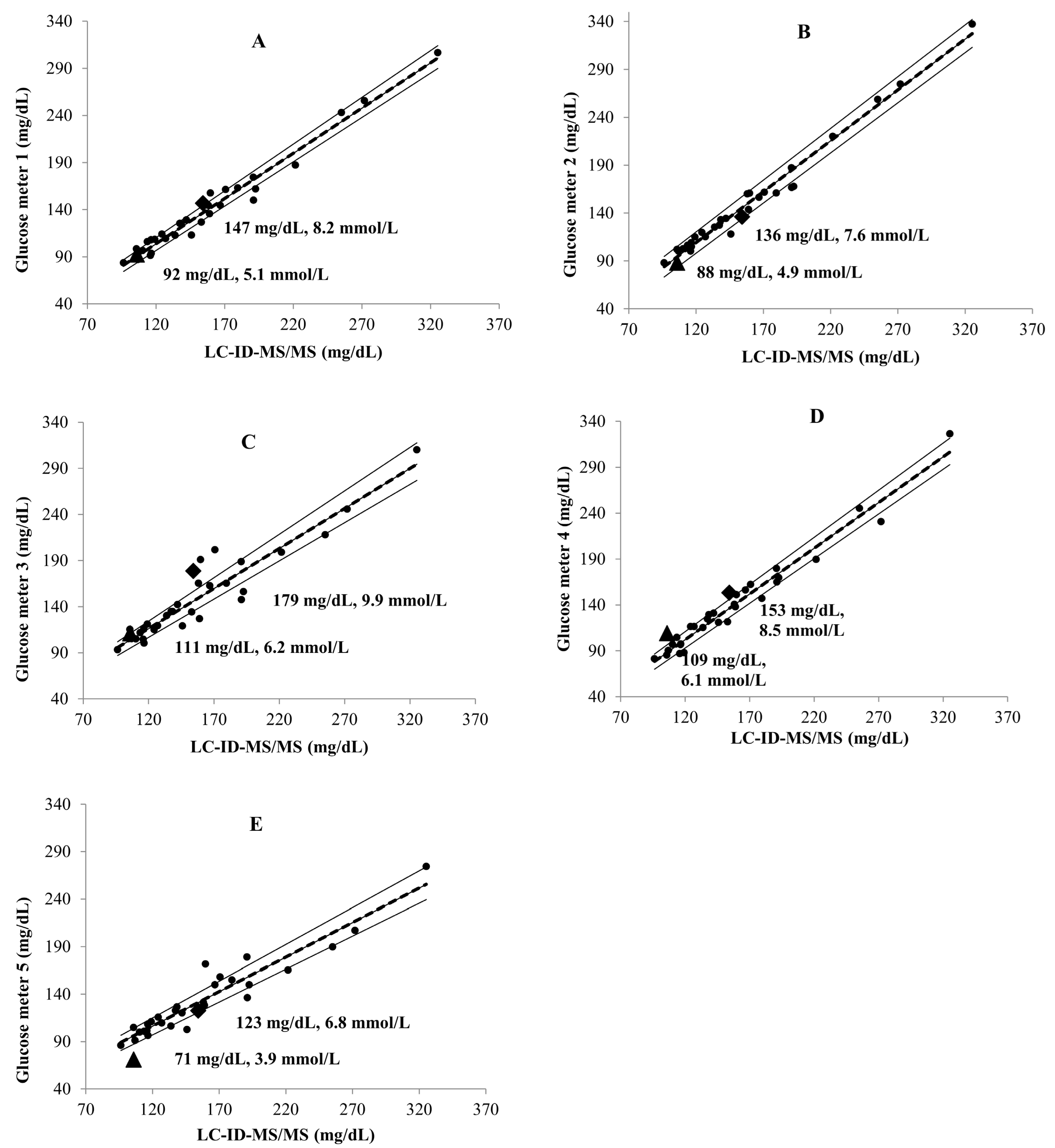Commutable Blood Materials from the Fixed-Cell Method for Performance Evaluation of Blood Glucose by a Glucose Meter
Abstract
1. Introduction
2. Materials and Methods
2.1. Instruments
2.2. Native Blood Samples
2.3. Processed Blood Material
2.4. Determination of Glucose in Unprocessed Native Blood and PBMs
2.5. Homogeneity of Glucose in PBMs
2.6. Stability of Glucose in PBMs
2.7. Commutability Assessment
2.8. Performance Evaluation of Blood Glucose Measurement by Glucose Meters Using PBMs
2.9. Statistical Analysis
3. Results
3.1. Homogeneity of Glucose in PBMs
3.2. Stability of Glucose in PBMs
3.3. Commutability of Glucose
3.4. Performance of Blood Glucose by Two Glucose Meters
4. Discussion
5. Conclusions
Author Contributions
Funding
Institutional Review Board Statement
Informed Consent Statement
Data Availability Statement
Acknowledgments
Conflicts of Interest
References
- Czupryniak, L.; Barkai, L.; Bolgarska, S.; Bronisz, A.; Broz, J.; Cypryk, K.; Honka, M.; Janez, A.; Krnic, M.; Lalic, N.; et al. Self-monitoring of blood glucose in diabetes: From evidence to clinical reality in Central and Eastern Europe—Recommendations from the international Central-Eastern European expert group. Diabetes Technol. Ther. 2014, 16, 460–475. [Google Scholar] [CrossRef]
- Freedman, D.B. Clinical governance: Implications for point-of-care testing. Ann. Clin. Biochem. 2002, 39, 421–423. [Google Scholar] [CrossRef] [PubMed]
- Rajendran, R.; Rayman, G. Point-of-care blood glucose testing for diabetes care in hospitalized patients: An evidence-based review. J. Diabetes Sci. Technol. 2014, 8, 1081–1090. [Google Scholar] [CrossRef] [PubMed]
- Kost, G.J. Newdemics, public health, small-world networks, and point-of-care testing. Point Care. 2006, 5, 138–144. [Google Scholar] [CrossRef]
- Lee-Lewandrowski, E.; Gregory, K.; Lewandrowski, K. Point of care testing in a large urban academic medical center: Evolving test menu and clinical applications. Clin. Chim. Acta 2010, 411, 1799–1805. [Google Scholar] [CrossRef] [PubMed]
- Clinical Laboratory Standards Institute (CLSI). Evaluation of Commutability of Processed Samples; Approved Guideline; CLSI Document EP14–A3; CLSI: Wayne, PA, USA, 2014; Available online: https://community.clsi.org/media/1432/ep14a3_sample.pdf (accessed on 12 February 2024).
- Bukve, T.; Sandberg, S.; Vie, W.S.; Sølvik, U.; Christensen, N.G.; Stavelin, A. Commutability of a Whole-Blood External Quality Assessment Material for Point-of-Care C-Reactive Protein, Glucose, and Hemoglobin Testing. Clin. Chem. 2019, 65, 791–797. [Google Scholar] [CrossRef] [PubMed]
- Wang, Y.; Plebani, M.; Sciacovelli, L.; Zhang, S.; Wang, Q.; Zhou, R. Commutability of external quality assessment materials for point-of-care glucose testing using the Clinical and Laboratory Standards Institute and International Federation of Clinical Chemistry approaches. J. Clin. Lab. Anal. 2020, 34, e23327. [Google Scholar] [CrossRef] [PubMed]
- ISO 17034: 2016; General Requirements for the Competence of Reference Material Producers. International Organization for Standardization: Geneva, Switzerland, 2016. Available online: https://www.iso.org/obp/ui/#iso:std:iso:17034:ed-1:v1:en (accessed on 12 February 2024).
- Guide 35: 2017; Reference Materials—Guidance for Characterization and Assessment of Homogeneity and Stability. 4th ed. International Organization for Standardization: Geneva, Switzerland, 2017. Available online: https://www.iso.org/standard/60281.html (accessed on 12 February 2024).
- Chen, Y.; Liu, Q.; Yong, S.; Lee, T.K. High accuracy analysis of glucose in human serum by isotope dilution liquid chromatography-tandem mass spectrometry. Clin. Chim. Acta 2012, 413, 808–813. [Google Scholar] [CrossRef] [PubMed]
- National Institute of standards and Technology Certificate of Analysis, Standard Reference Material 917c D-Glucose (Dextrose). Available online: https://www-s.nist.gov/srmors/view_cert.cfm?srm=917CNIST (accessed on 12 February 2024).
- National Institute of standards and Technology Certificate of Analysis, Standard Reference Material 965b Glucose in Frozen Human Serum. Available online: https://tsapps.nist.gov/srmext/certificates/965b.pdf (accessed on 12 February 2024).
- James, L.; Winfrey, H.J. Whole blood control sample. United State Patent #US4731330A, 15 March 1998. [Google Scholar]
- ISO 13485: 2016; Medical Devices-Quality Management Systems-Requirements for Regulatory Purposes. International Organization for Standardization: Geneva, Switzerland, 2016. Available online: https://www.iso.org/standard/59752.html (accessed on 12 February 2024).
- ISO 15189:2012; Medical Laboratories-Requirements for Quality and Competence. International Organization for Standardization: Geneva, Switzerland, 2012. Available online: https://www.iso.org/standard/56115.html (accessed on 12 February 2024).
- ISO/IEC 17043: 2010; Conformity Assessment-General Requirements for Proficiency Testing. International Organization for Standardization: Geneva, Switzerland, 2010. Available online: https://www.iso.org/standard/29366.html (accessed on 12 February 2024).
- ISO 13528: 2015; Statistical Methods for Use in Proficiency Testing by Interlaboratory Comparison. International Organization for Standardization: Geneva, Switzerland, 2015. Available online: https://www.iso.org/standard/56125.html (accessed on 12 February 2024).
- ISO 15197: 2013; In Vitro Diagnostic Test Systems-Requirements for Blood-Glucose Monitoring Systems for Self-Testing in Managing Diabetes Mellitus. International Organization for Standardization: Geneva, Switzerland, 2013. Available online: https://www.iso.org/standard/54976.html (accessed on 12 February 2024).
- National Climatic Data Center. Weather Profile of Thailand. 2016. Available online: http://www.climate.tmd.go.th/content/file/728 (accessed on 30 April 2021).
- Apiratmateekul, N.; Duanginta, W.; Phetree, M.; Kongros, K.; Treebuphachatsakul, W. Effects of Simulated Adverse Environmental Conditions Related to Actual Conditions at Health Promoting Hospitals on the Performance of Blood Glucose Testing by Glucose Meters. J. Diabetes Sci. Technol. 2023, 17, 125–132. [Google Scholar] [CrossRef] [PubMed]


| PBMs | Mean (mg/dL) | CV (%) | Fcalculate | Fcritical | Interpretation |
|---|---|---|---|---|---|
| BG62—002 | 99 | 1.16 | 1.53 | 3.02 | Adequate |
| BG62—001 | 135 | 1.33 | 2.28 | 3.02 | Adequate |
| Day | BG62—001 | BG62—002 | ||||
|---|---|---|---|---|---|---|
| Tcal | Tcritical | Interpretation | Tcal | Tcritical | Interpretation | |
| 60 | 1.41 | 2.31 | Acceptable | 1.91 | 2.31 | Acceptable |
| 90 | 2.12 | 2.16 | Acceptable | 0.44 | 2.16 | Acceptable |
| 120 | 1.93 | 2.10 | Acceptable | 0.18 | 2.10 | Acceptable |
| 150 | 0.03 | 2.07 | Acceptable | 0.06 | 2.07 | Acceptable |
| 180 | 0.07 | 2.05 | Acceptable | 0.02 | 2.05 | Acceptable |
| PBM | Mean ± SD (mg/dL) | |||||
|---|---|---|---|---|---|---|
| LC-ID-MS/MS | Glucose Meter 1 Amp-GDH-PQQ | Glucose Meter 2 Amp-GDH-FAD | Glucose Meter 3 Amp-GOD | Glucose Meter 4 Pho-GOD | Glucose Meter 5 Amp-GDH-FAD | |
| BG62—001 | 154 ± 0.9 | C 147 ± 1.7 −7 (4.9%) A | C 136 ± 4.4 * −18 (13.4%) B | NC 179 ± 6.7 ** 25 (13.7%) B | NC 153 ± 7.8 −1 (0.5%) A | C 123 ± 3.2 ** −31 (25.7%) B |
| BG62—002 | 106 ± 1.4 | C 92 ± 1.2 * −14 (14.7%) B | C 88 ± 2.7 * −18 (20.3%) B | C 111 ± 8.2 5 (4.6%) A | NC 109 ± 2.9 3 (3.1%) A | NC 71 ± 2.7 ** −35 (49.2%) B |
| Glucose Meter | 1 Amp-GDH-PQQ (n = 767) | 2 Amp-GDH-FAD (n = 266) |
|---|---|---|
| Range | 79–157 | 113–138 |
| Robust mean ± robust SD | 141 ± 6.2 * | 124 ± 4.5 ** |
| Satisfaction | ||
| LC-ID-MS/MS Mean ± SD (154 ± 0.9 mg/dL) | 761 (99.2%) | 17 (6.4%) |
| Consensus values Robust mean ± robust SD | 761 (99.2%) | 266 (100.0%) |
| Glucose Meter | 1 Amp-GDH-PQQ (n = 743) | 2 Amp-GDH-FAD (n = 246) |
| Range | 91–127 | 79–109 |
| Robust mean ± robust SD | 102 ± 3.6 * | 90 ± 3.7 ** |
| Satisfaction | ||
| LC-ID-MS/MS Mean ± SD (106 ± 1.4 mg/dL) | 741 (99.7%) | 112 (45.5%) |
| Consensus values Robust mean ± robust SD | 739 (99.5%) | 245 (99.6%) |
Disclaimer/Publisher’s Note: The statements, opinions and data contained in all publications are solely those of the individual author(s) and contributor(s) and not of MDPI and/or the editor(s). MDPI and/or the editor(s) disclaim responsibility for any injury to people or property resulting from any ideas, methods, instructions or products referred to in the content. |
© 2024 by the authors. Licensee MDPI, Basel, Switzerland. This article is an open access article distributed under the terms and conditions of the Creative Commons Attribution (CC BY) license (https://creativecommons.org/licenses/by/4.0/).
Share and Cite
Apiratmateekul, N.; Nammoonnoy, J.; Kost, G.J.; Treebuphachatsakul, W. Commutable Blood Materials from the Fixed-Cell Method for Performance Evaluation of Blood Glucose by a Glucose Meter. Diagnostics 2024, 14, 799. https://doi.org/10.3390/diagnostics14080799
Apiratmateekul N, Nammoonnoy J, Kost GJ, Treebuphachatsakul W. Commutable Blood Materials from the Fixed-Cell Method for Performance Evaluation of Blood Glucose by a Glucose Meter. Diagnostics. 2024; 14(8):799. https://doi.org/10.3390/diagnostics14080799
Chicago/Turabian StyleApiratmateekul, Napaporn, Jintana Nammoonnoy, Gerald J. Kost, and Wanvisa Treebuphachatsakul. 2024. "Commutable Blood Materials from the Fixed-Cell Method for Performance Evaluation of Blood Glucose by a Glucose Meter" Diagnostics 14, no. 8: 799. https://doi.org/10.3390/diagnostics14080799
APA StyleApiratmateekul, N., Nammoonnoy, J., Kost, G. J., & Treebuphachatsakul, W. (2024). Commutable Blood Materials from the Fixed-Cell Method for Performance Evaluation of Blood Glucose by a Glucose Meter. Diagnostics, 14(8), 799. https://doi.org/10.3390/diagnostics14080799







